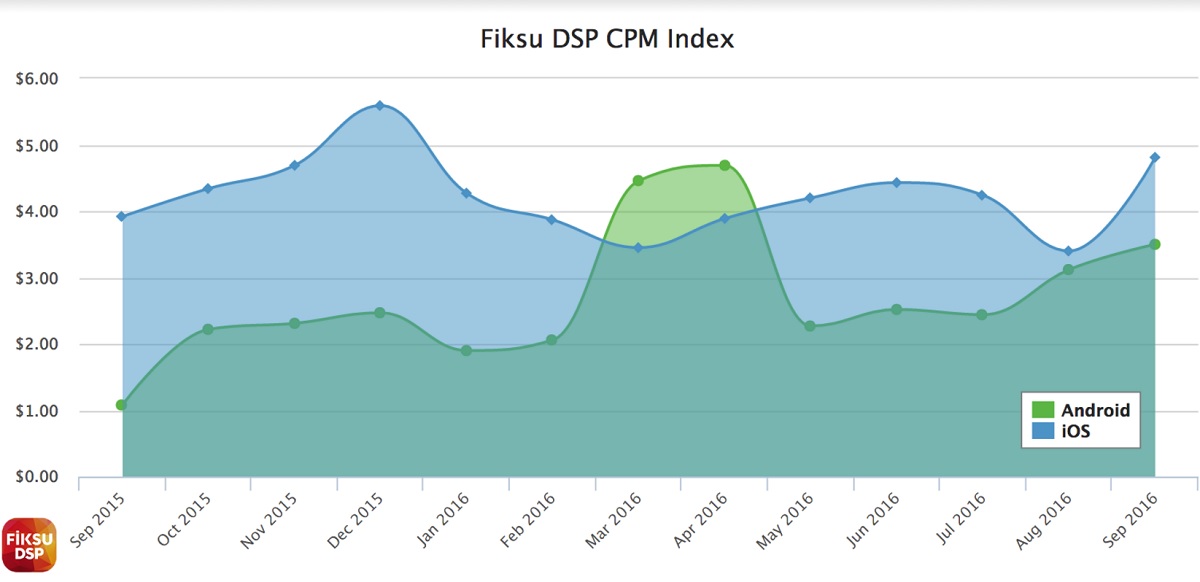
Mobile advertisers are spending more money on Android, according to September data on mobile ad spending from a report by mobile marketing firm Fiksu DSP.
Apple’s iOS remains the more competitive platform for mobile ads, but advertisers are willing to pay higher mobile ad prices across both platforms now.
Fiksu’s new indexes, launched today, measure cost per thousand impressions (CPM) and cost per purchaser (CPP) across a wide range of mobile real-time bidding (RTB) traffic. The data shows that Android is maturing; while iOS used to be the gold standard, now there is significant opportunity for advertisers in Android, Fiksu said.
“It’s clear looking at these metrics that among advertisers, Android is no longer an afterthought. Marketers know what to expect from iOS, including what they’ll earn and what they have to pay per user, so costs have settled into a more stable range,” said Micah Adler, CEO and founder of Fiksu DSP, in a statement. “Now, monetization levels on Android are proving that it can be as effective as iOS in terms of bottom line dollars, which is sending a signal to developers, publishers and marketers that they should be putting more effort and money into their Android apps.”
The company is introducing these two new indices, built using data reported via the Fiksu software development kit (SDK), to align with its focus on real-time bidding and to illustrate the open nature of RTB, which helps reduce the influence of “walled garden” advertising channels.
The CPM index, measuring the cost per thousand ad impressions across a wide range of exchanges (including Mopub, Ad-X, Nexage, OMAX, and more) and ad formats (display, interstitial, native, video, and playable), reveals the relative competition for mobile ad impressions.

Above: Cost per purchaser was relatively flat in September, but it is up dramatically from a year ago.
The CPP index looks further down the marketing funnel, measuring how much advertising spend it takes to capture one user who takes a high-value action within an app. Typically a transaction, in some cases the action might be a registration or a social share, depending on what a particular app has tagged as its key metric. Because exact dollar values vary so much on this scale, this index was set to a baseline value of 100 for June of 2015 and adjusted proportionally to reflect changes over time.
Competition for ads on the Android platform was roughly flat from August to September, with CPM dropping one percent to $3.50, but up more than 112 percent from the same month in 2015.
CPP on Android dropped 14 percent since August, but has also grown at a steady clip year-over-year, rising 59 percent since September of 2015.
Increasingly, marketers are discovering the most effective and profitable ways to monetize on the Android platform, and, as a result, showing more willingness to pay more per user, Fiksu said. But the Android market has not reached the same level of saturation as iOS, leaving an opportunity for marketers to reach people at a lower cost.
Having said that, the iOS market remains the standard, and it is stable, with slight gains during periods in which Apple launched new devices. While CPM on iOS remains considerably higher than Android, as it has for several years, it was up 23 percent for the month and up 8 percent since September of 2015, to $4.81. The CPP on iOS rose just 1 percent month-over-month, but is up 76 percent since last September.
Last year, the iPhone 6 and 6S had a strong launch, and performance marketers seized that opportunity to target prime users downloading new apps. While last month’s iPhone launch showed slower initial adoption rates, likely due to new launch fatigue, users of those new phones tend to be very good potential users, keeping cost per purchaser down even as marketers drove up CPM trying to reach them.
“From last year to now, it’s evident that both operating systems are experiencing changes that are largely a function of maturity,” said Tom Cummings, vice president of new market development at Fiksu DSP, in a statement. “This gives us some insight into what the future might hold as well: While cost spikes are still expected during the holiday seasons and around other launches, overall costs for inventory and per active user are expected to remain far more stable on iOS than in the Android market.”
Source: VB

You must be logged in to post a comment Login